Chances are you spend most of your gym time moving in just one direction.
Think about it: Standard gym moves like lunging, squatting, and running are all variations on front-to-back movement. So are lying-down exercises like presses and crunches, and machine-based moves like rows and curls. In every case, you move your body (or parts of it) forward and back, as if walking down a narrow alley.
Outside the gym, of course, it’s a different story: You twist, you turn, you bend. You step in all directions. You’re a three-dimensional mover.
Fitness pros have terms for each of these dimensions, or planes of action: the sagittal plane, which covers all those front-to-back gym moves; the frontal plane, which describes side-to-side movements like jumping jacks and side shuffles; and the transverse plane, which includes rotational motions that involve twisting or turning, like swinging a bat or throwing a ball.
Of these three planes, gym-goers are most likely to neglect the transverse plane — and that’s a mistake. In our day-to-day lives, we rotate all the time: to check for oncoming traffic, to pass the salt to the person next to us, to put on a jacket. And rotation may be even more vital in recreational activities: You can’t play golf or tennis, or practice yoga or the martial arts, without lots of turning and twisting action through your spine, shoulders, and hips.
The most important reason to include transverse work in your routine has nothing to do with adding yardage to your drive or power to your punch, however. “Primarily, transverse training helps prevent injury,” says Ben Bruno, a strength coach at Mike Boyle Strength & Conditioning in North Andover, Mass. Here’s why: The muscles that function in the transverse plane — such as the obliques on the sides of your torso — don’t just help you rotate; they prevent you from rotating too much.
In tennis, for instance, you need to rotate powerfully in one direction as you swing through the ball, then slow down to a stop just milliseconds later. Working some transverse-plane moves into your gym sessions can help a player develop this ability to “anti-rotate” — to slow down or stop from over-rotating when twisting and turning with force and speed.
What follows is a full-body strength-training workout consisting of exercises that challenge you to twist and turn strongly and safely. Perform once a week as described, or substitute any of the individual moves for their more standard equivalents (listed along with each exercise) whenever you want to add a twist to your workout.
The Transverse-Plane Workout
Instructions: After a brief warm-up, perform the following six exercises in the order described.
- Perform exercises A and B as straight sets (do a set, rest for 30 seconds and repeat).
- On C1 and C2, do a set of C1, rest a minute, do a set of C2, rest, and repeat until you’ve done four sets of each exercise.
- Perform exercises D1 and D2 in a similar manner for a total of three sets of each movement.
Workout designer Ben Bruno says you should “twist through the torso, and not the spine” when doing these transverse-plane exercises.
A) Rotational Lunges
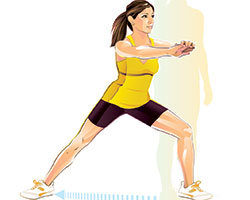
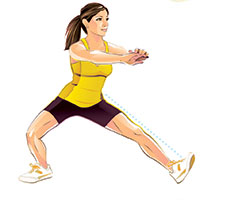
- Stand with feet parallel and shoulder-width apart.
- Step right foot backward and to your right one long stride (when your foot lands, it will be as if you are standing on diagonal corners of a large square).
- Rotate right foot outward so that toes point directly out to the side.
- Extend arms directly in front of you.
- Keeping lower back in its natural arch and left leg straight, bend right knee and lower yourself as far as possible. To deepen the lunge, try lifting toes on left foot.
- Reverse the movement and return to the starting position.
- Repeat the move, this time stepping back with your left leg.
- Alternate sides until you have completed 10 reps on both sides.
Sets and Reps: Two sets of 10 per leg
Substitute for: Walking lunges, reverse lunges
The Finer Points: “The rotational lunge is great for hip mobility,” says Bruno, which makes it a terrific exercise for preventing injury in the lower back and knees, and a solid warm-up.
B) Rotational Medicine-Ball Throw
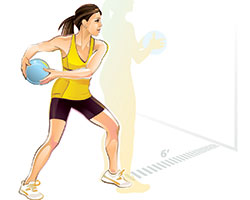
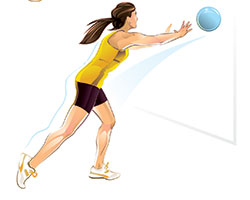
- Select a medicine ball that’s about 5 percent of your body weight.
- Holding the ball near the center of your chest, stand upright, feet parallel and slightly wider than shoulder width, facing about 6 feet from a brick or cinderblock wall.
- Turn your whole body to your right so your left shoulder points directly toward the wall.
- In one explosive, powerful movement, turn your torso to your left and throw the ball against the wall as hard as possible, keeping your right foot stationary.
- Catch — or retrieve — the ball and repeat for 10 reps.
- Repeat the movement with your right shoulder facing the wall.
Sets and Reps: Two sets of 10 per side
Substitute for: Medicine-ball overhead throws, medicine-ball slams, explosive pushups
The Finer Points: Don’t leave your feet out of the exercise. Your trailing foot — the one farthest from the wall — should turn inward, along with your hips and shoulders.
C1) Landmine Reverse Lunge
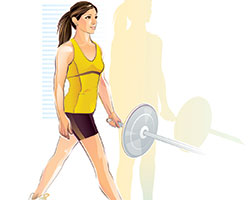
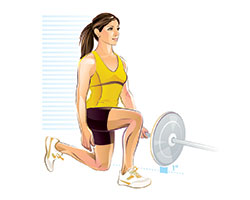
- Stand upright facing the end of a landmine bar.
- Take hold of the free end of the bar with your left hand, and stand with the bar near the outside of your left thigh.
- Keeping shoulders and hips square and feet pointing forward, take a long step back with left foot and place the ball of that foot on the floor behind you.
- With torso upright, slowly bend both legs, lowering your left knee until it is about an inch from the floor.
- Reverse the movement until you are standing again, feet lined up next to
- each other.
- Repeat the movement for the appropriate number of reps, stepping the left foot back each time, then perform the movement stepping the right foot back, this time holding the bar in your right hand.
Sets and Reps: Four sets of eight
Substitute for: Barbell lunges, dumbbell lunges
The Finer Points: If you don’t have access to a landmine unit, brace one end of a standard Olympic bar in the corner of the gym or against a couple of weight plates on the floor, and lift the opposite end.
C2) One-Arm Dumbbell Bench Press
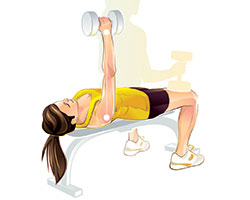
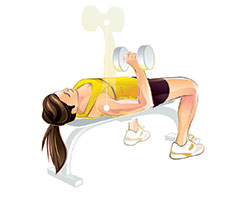
- Sit on the end of an exercise bench, feet shoulder-width apart, parallel, and flat on the floor. Hold a heavy dumbbell in your right hand.
- Place the dumbbell on top of your right thigh with its handle vertical.
- Slowly lean backward until you are lying on the bench; simultaneously raise the dumbbell overhead, so that your right arm is straight and the dumbbell is directly above the right wrist and shoulder.
- Without twisting your spine, bend your right arm and lower the dumbbell, allowing your wrist to rotate naturally so your palm faces your knees, until you feel a mild stretch across the right side of your chest.
- Reverse the move, pressing the dumbbell upward until your arm is straight.
- Repeat the movement for the appropriate number of reps with the right arm before switching the weight to the other arm.
Sets and Reps: Four sets of eight reps per arm
Substitute for: Dumbbell bench press, barbell bench press
D1) Three-Point Dumbbell Row
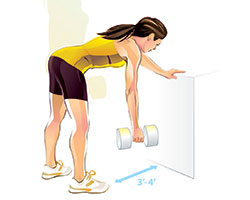
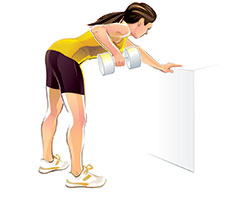
- Holding a moderately heavy dumbbell in your right hand, stand 3 or 4 feet behind a sturdy, waist-high box or bench.
- Bend forward at the waist and brace your left hand firmly on the box in front of you, allowing your right arm to hang down toward the floor.
- Keeping your lower back in its natural arch and your shoulders square (right shoulder level with your left), pull the dumbbell upward toward your armpit as far as you can.
- Reverse the movement, lowering the dumbbell under control back to the starting position.
- Repeat the movement for the appropriate reps with the right arm before switching to the other side.
Sets and Reps: Three sets of eight
Substitute for: Machine row, barbell row, TRX row
The Finer Points: “I often see people heaving a very heavy weight on this move, like they’re starting a lawnmower,” says Bruno. Instead of doing that, he suggests, lighten the load and keep your shoulders level throughout the exercise.
D2) Landmine Romanian Deadlift
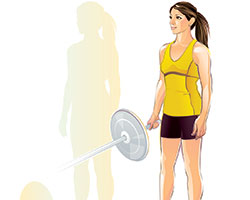
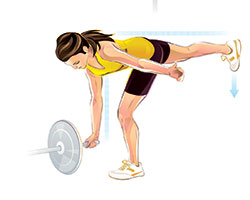
- Stand in front of a landmine device with the end of the barbell pointing toward you.
- Bend, grip the end of the barbell in your right hand, and stand with the end of the barbell by your right side.
- Shift weight onto left foot and lift your right foot a few inches off the floor.
- Keeping your back in its natural arch, right leg and hip extended, and toes of your right foot pointing toward the floor, hinge forward on your left hip.
- Hinge forward until balancing on left foot with right arm reaching toward the floor, left arm held out to the side for balance, and right leg and torso parallel to the floor.
- Slowly return to the starting position, attempting to maintain optimal balance throughout the movement.
- Complete all reps on your left leg, then switch to your right foot and repeat.
Sets and Reps: Three sets of eight on each leg
Substitute for: Single-leg Romanian deadlift, stiff-leg deadlift
WEBEXTRA
Pallof Press
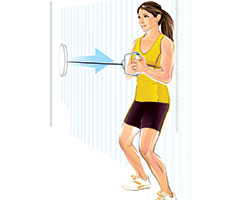
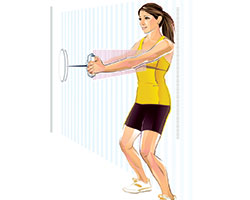
- Set the pulley on a cable machine at chest height and attach a D-handle (the steel attachment with a rotating handle typically used for one-handed cable exercises) to the cable.
- Interlock the fingers of both hands around the handle and walk back several feet to create tension on the cable.
- Turn your body so that your right shoulder points directly toward the machine.
- Assume an athletic stance (knees slightly bent, chin tucked, back upright, shoulder blades back and down, feet at shoulder width) and hold the D-handle against your torso at sternum height with its handle vertical.
- Slowly extend your arms until your hands are directly in front of the middle of your chest, maintaining an upright posture and keeping the D-handle vertical throughout the movement.
- Pause in this position for a moment, then pull then handle back to the starting position.
- Repeat for the appropriate number of reps, then turn and perform the move with your left shoulder toward the machine.
Sets and Reps: Three sets of eight per side.
Substitute for: Side planks, twisting crunches, twisting situps.
The Finer Points: For an added challenge, hold the extended position for a slow 10-count.
This article has been updated. It originally appeared in the October 2013 image of Experience Life.
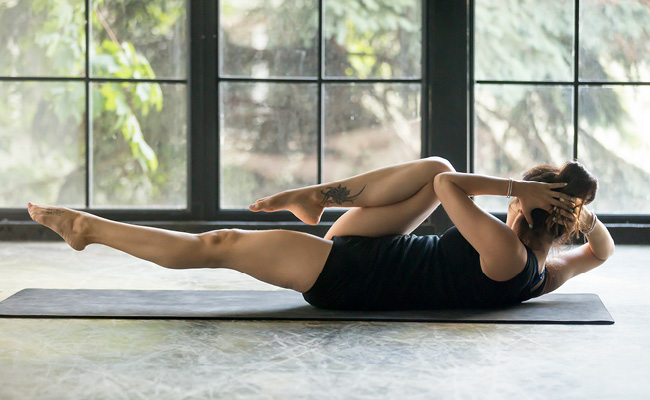

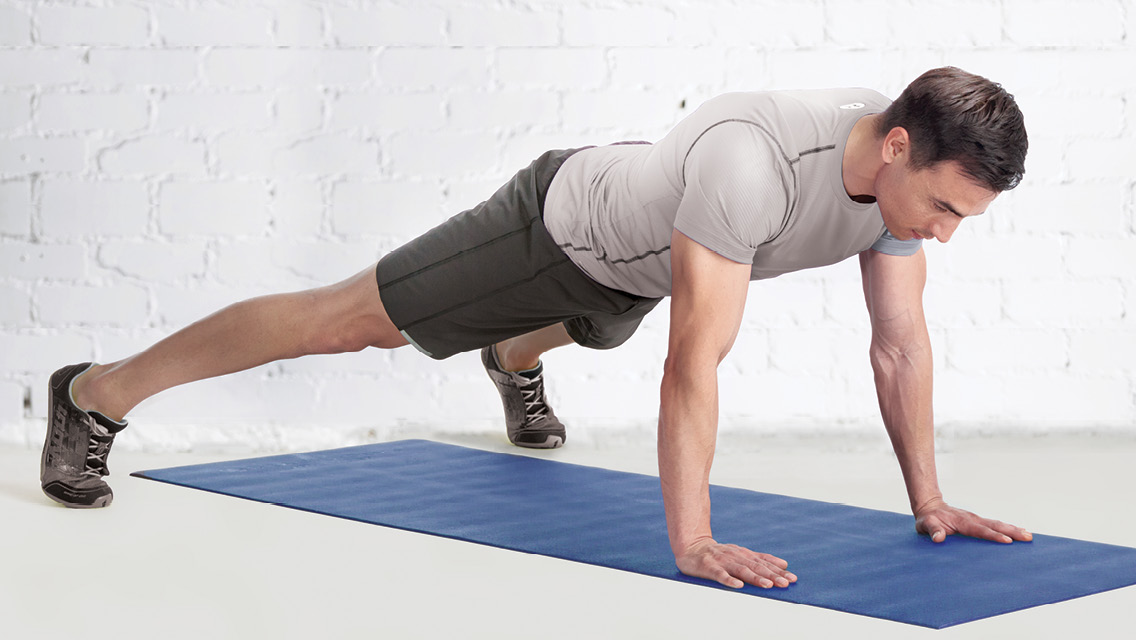

This Post Has 0 Comments